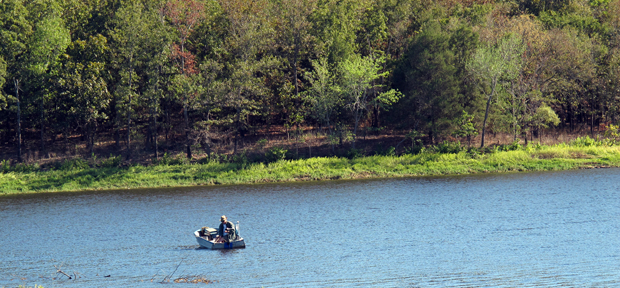
A Tale of Two Cities: Paying For Parks When the State Trims Its Budget
-
Logan Layden

LOGAN LAYDEN / NPR STATEIMPACT
Shay Williams steers his ATV races across the sand at Beaver Dunes, the management of which was recently transferred from the state to the City of Beaver.
Along a dead-straight expanse of State Highway 23, the rolling hills of the Oklahoma Panhandle give way to wind swept sand dunes.
Roadrunners scurry as Shay Williams revs the engine of his ATV and races across the little slice of desert known as Beaver Dunes Park — formerly Beaver Dunes State Park. That was before it was taken over by the small town of Beaver in mid-August.
“We came out here to dove hunt, and thought, ‘Well, we’d kill two birds with one stone while we’re here.’ Do a little riding and do a little hunting,” Williams said.
In March, the Oklahoma Department of Tourism announced plans to close seven state parks, a move that reflects a national trend. In California, 70 parks are set to close, and 23 Texas parks are cutting services, hours and staff.
All seven of Oklahoma’s parks — Adair, Boggy Depot, Heavener Runestone, Brushy Lake, Beaver Dunes, Wah-Sha-She and Lake Eucha — will remain open. Cities will manage five of the parks and American Indian tribes have assumed control of the other two.
The state tourism department saw its budget cut by more than 22 percent since 2009, and officials expect the transfers to save taxpayers $700,000 a year.
Parks Director Kris Marek said the agency was left with little choice but to close some smaller or duplicate parks with relatively low attendance. Now communities are scrambling to come up with the money to keep the parks open.
“So far we’ve had to take $5,000 dollars out of our public works to sustain the park,” said J.C. Moser, the city administrator in Beaver. “That gives money back to putting in water lines, putting in fire hydrants, putting in upgrades in our sewer system and trash hauling and stuff.”
Moser said Beaver Dunes is important to the local economy, and is worth a few adjustments to the town’s budget. He’s actually happy the state no longer controls the park.
“I think it’s a plus for us to have local control over it,” Moser said. “The full-time park ranger that we had out there moved away or resigned or something three years ago, and it was just going downhill, downhill, downhill. Certain parts of the park you couldn’t even use anymore it deteriorated so badly.”
Beaver Dunes only costs about $60,000 per year to operate, and it’s in western Oklahoma, where taxes from the energy industry blunted the effects of the economic downturn.
In eastern Oklahoma — where six of the seven former state parks are — oil and gas money is more rare, unemployment is higher, and city budgets are tighter.

LOGAN LAYDEN / NPR STATEIMPACT
A man on the water at Brushy Lake, a former state park now managed by the city of Sallisaw.
The City of Sallisaw recently took control of Brushy Lake. City Manager Bill Baker said reductions in park services and fewer employees are bringing the park’s nearly quarter of a million dollar annual cost down, but running the park is about $70,000 annual burden Sallisaw officials would rather not shoulder.
“Well it’s a negative in that we could have used that money for other things,” Baker said. “I mean, to make improvements — other improvements maybe to salaries and benefits for employees, or we may could’ve bought some equipment that we didn’t include in the budget. You know, $70,000 would’ve bought two police cars.”
Baker said he knows tough choices had to be made at the state level to deal with the budget crisis, but joins Beaver officials in criticizing the tourism and recreation department for failing to seek more local input into the decision to close parks.
“We, at least myself personally, heard about this in the newspaper,” he said. “So we kind of felt like the state was pulling out of this and just leaving us holding the bag.”
